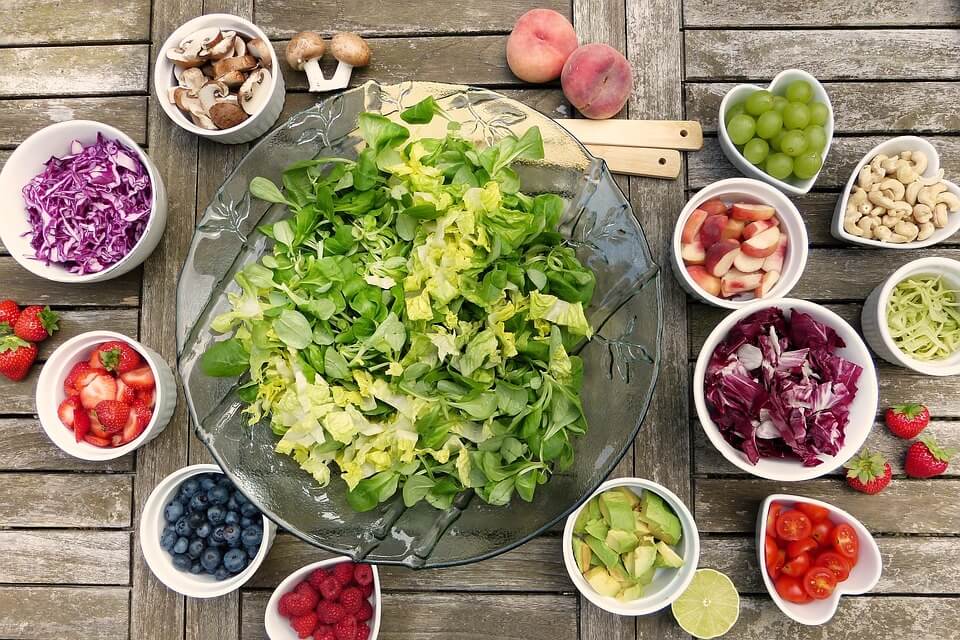The main goal of yoga is spiritual development. It helps you develop self-awareness and self-regulation. As you master it, you become more conscious of what’s going on in your body and surroundings. As a result, you’re calmer, happier, and more at peace.
Apart from your spiritual well-being, you achieve optimum physical health, too. The poses increase your flexibility, balance, and coordination. It strengthens the bones and tones the muscles. Yoga also improves sleep quality and relieves pain. Spend some time on the mat regularly, and you’ll get a body that looks good and functions well.
My years of yoga has taught me, moreover, that the principles of yoga should be carried beyond the yoga studio. And one of the most crucial aspects is to keep your diet in check.
The Diet of a Yogi
Eating well, in my opinion, should be part of your lifestyle, if you really want to achieve the goals of yoga. Imagine if you spend hours on the mat practicing various poses but feed yourself with loads of sugar and unhealthy oils. It would just nullify the good that yoga does to your body. And it also won’t give you the nutrients to sustain the mind and body.

But is there an official diet for yoga?
Yoga is an ancient practice with a lot of literature about it. But classic yoga texts, such as the Yoga Sutra and the Bhagavad Gita, did not mention specific foods. And that’s a good thing, I think. Not everyone has access to the Indian ingredients that they would have listed. And people have different needs, depending on their lifestyles, body builds, the seasons, and more.
There are, however, general rules to live by if you want to adhere to the principles of yoga:
- Be mindful of the ingredients of your food. I recommend fresh, organic fare.
- Steer clear of processed foods.
- Do not stuff yourself with food. Stop eating when you feel satisfied.
- Drink plenty of liquids. It is recommended that men take 3.7 liters of fluids, while women take 2.7 liters. The need increases as your daily activities become more strenuous, so adjust accordingly.
Should You Go Vegan?
One of the most polarizing aspects of the yoga diet is the ahimsa, the principle of non-harming. It advocates against violence towards the self and others, while keeping in harmony with one’s personality.
Different people have varying interpretations of this principle, just like how they have different versions of poses. Some yoga instructors I know prescribe veganism as a way of embracing ahimsa. They believe that to adhere to the ahimsa, one must not do harm to anyone, animals included.
Others, meanwhile, adopt an omnivorous diet, which consists of a healthy balance of meat, grains, vegetables, and fruits, among others. After all, it is what works physiologically for them. They use the energy they get from humanely produced meat and fish to heal themselves, teach, and help people.
So, if you ask me, going vegan is entirely up to you. I can prescribe no right or wrong way — it all depends on your personal ethics and what feels right to you. Consider your physiological conditions, as well. Some people are allergic to grains, which makes it extremely difficult for them to go vegan.
If you can, weigh in on what you believe in. And think of the pros and cons of veganism, too. But, ultimately, do what’s best for your body.



Planning a Yogi Diet
In yogic philosophy, all things are composed of three qualities: Raja, Tama, and Sattva.
- Raja refers to the quality of being hot, fast, passionate, and action-packed. These are foods that are spicy, salty, and bitter. These have a stimulating effect, like caffeinated drinks, chocolate, and spices. These should be taken in moderation.
- Tama is the characteristic of being slow, bland, and lethargic. These have a sedative effect on the mind and body. Tamasic foods include meat, alcohol, tobacco, and fermented foods. Like Rajasic foods, these should be taken in moderation.
- Sattva refers to the attributes of purity and harmony. Sattvic foods should compose most of your diet, as these nourish and detoxify the body and help you maintain a peaceful state. These include vegetables, fruits, milk, nuts, seeds, and teas. If you decide to go vegan, you may opt for coconut or almond milk.
The Right Time to Eat
Your body works best when it works in cycles. When you eat during regular hours, the body anticipates the intake of calories and utilizes nutrients better.
I recommend not eating for two hours before exercise or sleep. This way, the body won’t redirect the energy supposedly for digestion to exercise. Similarly, digestion won’t take energy away from tissue repair, hormone production, and fighting infection during sleep.
Sticking to Your Meals
Admittedly, it’s pretty hard to stick to a yoga diet. My students often tell me they’re tempted to abandon it altogether, in fact. But think about the benefits the diet would give you, I often tell them. Sticking to your diet helps you get the most out of yoga. You feel cleaner, healthier, and more energetic.
So, here are some tips:
- Remind yourself of your motivations – Make a list of everything that motivates you. You want to adhere to yogic principles and get the most out of yoga. You want to have a healthier weight, toned muscles, stronger immune system, etc. Pull this list out whenever you feel discouraged.
- Don’t starve or stuff yourself– Take everything in moderation. It’s better to take several small portions than stuff yourself once then starve yourself for hours.
- Prepare a set of meals–Make sure they’re specific, so there’s no room for guesswork. For example, breakfast involves whole-grain bread, eggs, fresh fruits, and milk. For lunch, go for a green salad with tofu or chicken, avocado, and a simple dressing. For dinner, veggie tacos. Nuts, seeds, and fruits are great snacks.
- Have someone accountable – I recommend getting a diet buddy because it’s easier to stick to a plan when there’s two of you. If you can’t find one, get someone you can report to whenever you miss your diet. He or she will keep you in check.
There’s no “official” yoga diet—you alone could tell what works for your body. To get the most out of this ancient practice, you have to be mindful of what you eat. A diet fitted to your needs sets you on the path to better physical, mental, and spiritual health.
Check our site for more healthful insights.

